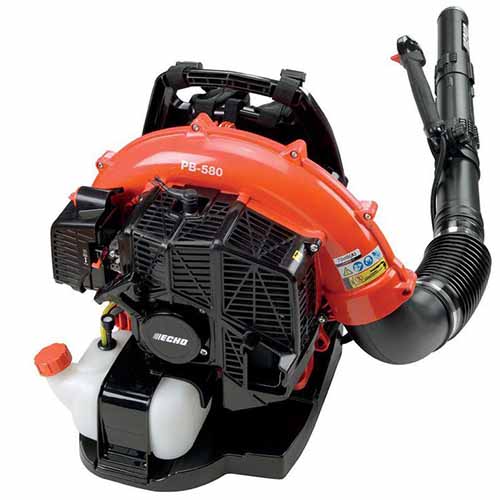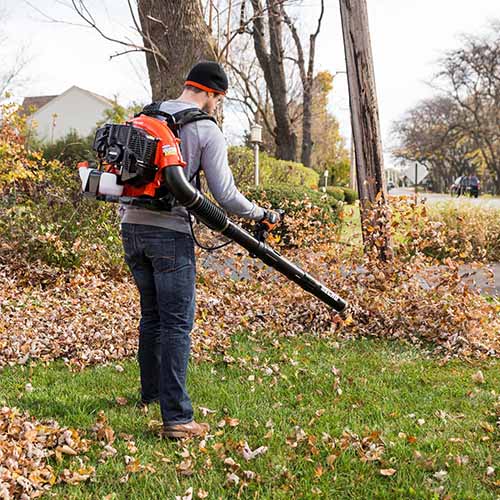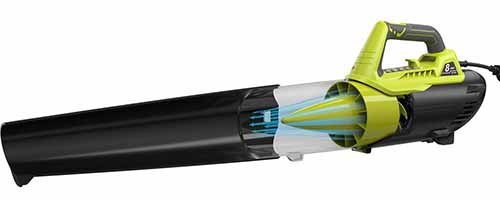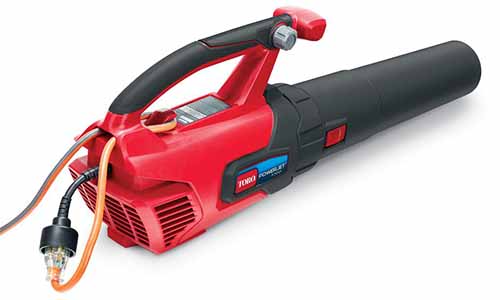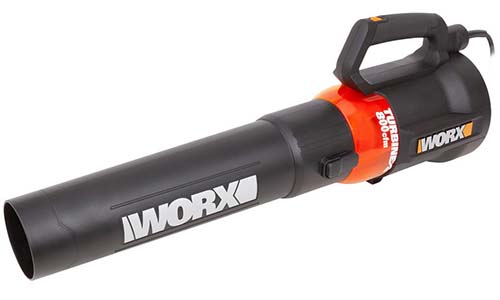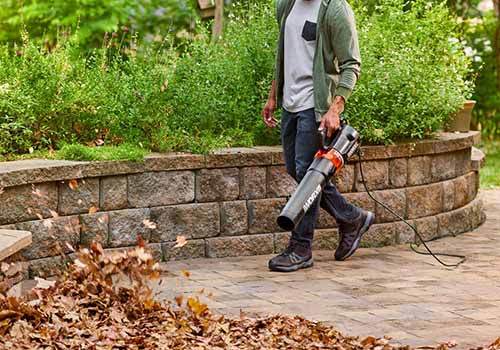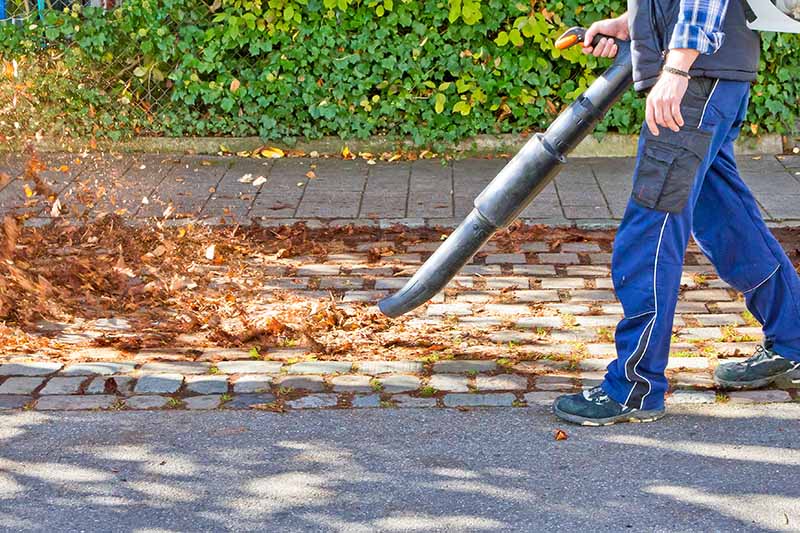In addition to clearing up leaves, a leaf blower can also help you remove grass clippings, other garden debris, and clean out gutters. Additionally, they are more efficient for use on driveways or parking areas than a rake. We link to vendors to help you find relevant products. If you buy from one of our links, we may earn a commission.
How to Choose a Leaf Blower
First, how do you decide whether you want a gas, corded, or cordless model? Cordless options rely on a rechargeable battery that limits their running time, and corded models – usually the lightest and quietest – have you tethered to an electrical outlet. We’ll cover this in more detail below.
And if you haven’t used one before, our buying guide will cover the basics of how the different types of leaf blower work, and what the technical terms mean. It’s not possible to state categorically which model is the best leaf blower, as this will depend on your specific needs. For small yards, a corded or cordless handheld model is often the most efficient. Those with larger yards may require the extra oomph of a gas-powered model. You can compromise on the weight by selecting a backpack blower, or even bring a hurricane into your yard with a walk-behind model. We’ve narrowed it down to nine different models to suit all budgets across the three main categories: cordless, corded, and gas-powered.
1. Echo PB-2620
If you need a gas handheld blower to clear leaves and debris from a large yard, you should consider the Echo PB-2620, available from Home Depot. This durable, professional-grade model has a 25.4 cubic centimeter two-stroke engine that produces 172 miles per hour maximum air speed, with an airflow of 456 cubic feet per minute. It’s noisy to the tune of 70 decibels.
Echo PB-2620 With variable speed, and a “cruise control” that allows you to lock it at your desired speed, it’s able to move heavy wet leaves and a variety of other yard debris. The air inlet at the side of the unit features a double grid design to prevent it from clogging or getting caught up in your clothes as you work. The two-stage air filter allows you to work in dusty conditions without damage to the engine. Two nozzles are supplied: a round and a flared-end tube so it’s versatile and can be used for a variety of cleanup operations.
This unit weighs just over nine pounds without gas. The translucent gas tank has a capacity of 20 fluid ounces, which gives you plenty of “gas in the tank” to get your yard chores done. In addition to the comfortable top handle, it has a secondary handle at the bottom of the unit for easy maneuverability and two-handed use. This model requires a 50:1 ratio of gas to oil or you can consider buying a pre-mixed product for ease of use. The Echo PB2620 comes with a five-year consumer warranty (or a two-year commercial warranty) for your peace of mind. See customer reviews and check prices now on Home Depot.
2. Echo PB-580T
If you need the additional power and comfort of a backpack model, you will not go wrong with the Echo PB-580T Backpack Blower, available at Home Depot. The Echo PB-580T features a 58.2 cubic centimeter two stroke engine that blows air at 215 miles per hour with a whopping 510 cubic feet per minute.
Echo PB 580T Backpack The padded, vented backrest and shoulder straps spread the additional weight of this powerful, 22-pound (without gas) model. The unique design of the backrest allows air to circulate, keeping you cool while you work, and it features a four-point vibration reduction system for added comfort. With a gas tank capacity of 62 fluid ounces, you’ll be able to clear up large areas for many hours before the unit needs refueling. The noise rating is 70 decibels, which is reasonable for the amount of power output this model provides. This unit has a tube-mounted throttle with variable speed cruise control. The air filter is pleated – like the one in your car – for superior performance and durability. With a backpack model, you don’t have to worry about your clothes being tangled in the air intake vents. The Echo PB-580T has a leaf guard to prevent leaves, dust, or debris blocking the intake and overheating the engine.
If you have a large lot, with numerous trees, this backpack unit will take the load off your arms and allow you to stay out longer for bigger cleanup efforts. A long, flexible tube allows you to maneuver around and under objects and the end of the nozzle has a metal ring around it to prevent breakage. The manufacturer recommends a 50:1 ratio of 89 octane (or higher) gas to oil. Alternatively, you can purchase a premixed product from TrueFuel via Home Depot that’s ready to use. The 50:1 ratio ships in a 32-ounce steel container and stays fresh for up to two years after opening. The Echo PB580T ships with a five-year consumer (two-year commercial) warranty. Check prices now at Home Depot.
3. EGO Power+ LB5804
EGO Power + LB5804 Delivering 580 cubic feet per meter and 168 miles per hour, the Ego Power+ tackles wet and dry leaves, and a variety of garden debris. The included five-amp, 56-volt lithium ion battery lasts for approximately 35 minutes and takes 90 minutes to recharge. This unit weighs just under 10 pounds with the battery attached. The air intake – located at the back of the unit – is shielded by the battery which prevents your clothes getting caught. A “turbo” setting allows you to crank up the power for short bursts and a cruise control lets you choose your ideal air speed. The softgrip handle is comfortable and features a speed dial for quick and easy adjustment with your thumb. If I had one quibble with this unit, it’s that the balance of the handle makes the nozzle tend to point downwards a little too much, which won’t be a problem for taller folks. This model delivers 68 decibels of neighborly noise. EGO provides a five-year warranty on the tool and a three-year warranty on the battery charger.
4. Greenworks 24252
Greenworks 24252 This lightweight machine weighs just seven pounds with the battery installed, and a two-piece extension tube increases your reach. A 40-volt lithium ion battery enables the motor to deliver a maximum air speed of 150 miles per hour and airflow of 135 cubic feet per minute. This model has a noise rating of 62 decibels. The relatively low CFM rating on this model makes it suitable for cleaning pathways and decks, and dry leaves from your lawn, but it will not handle large amounts of debris or wet leaves. With a battery life of 15-25 minutes, this unit is ideal for small-scale yard cleanup but it doesn’t pack the serious punch of some of the more powerful models. It features a flat-ended nozzle to focus the airflow and offers six speeds that can be selected from a dial on the comfortable handle. Greenworks offers a four-year warranty for your peace of mind. This unit is not the most powerful on our list by quite a long way, but it’s perfect for light cleanup of your deck, driveway, and yard. If you don’t require heavy-duty power, this model will get the job done.
5. Makita XBU02PT1
Makita XBU02PT1 The lithium ion battery is interchangeable with all other Makita cordless tools and provides a respectable 473 cubic feet per minute and 120 miles per hour. With a noise rating of 61 decibels, it won’t drive the neighbors completely crazy. The main downside to this model is the relatively short battery life. The two five-amp batteries last an average of 20-25 minutes on medium power, and even less on full power. This unit weighs just under ten pounds with two batteries installed. It ships with four batteries and they take about an hour to recharge. The handle features a dial that’s easy to reach and six power settings. The air intake on the back of the unit can snag loose clothing unless you keep it to one side. The manufacturer offers a one year warranty. This model is ideal for a small backyard, it’s powerful enough to make short work of your fall cleanup duties, and is especially useful for those users who already have a selection of Makita tools.
6. Ryobi RY42102
The Ryobi RY42102 is a budget-friendly handheld corded electric blower available at Home Depot. This basic model delivers a respectable 135 miles per hour and 440 cubic feet per minute. The 8-amp jet fan technology has two speeds so is not as highly adjustable as the Worx or the Toro models described below.
Ryobi RY42102 When it’s set on “low,” the blower pushes out 350 cubic feet per minute at 100 miles per hour. On the high setting, it delivers 440 cubic feet at 135 miles per hour. At just 65 decibels of racket, this is one of the quieter models. It will tackle wet and dry leaves, as well as lightweight garden debris. The comfortable softgrip handle allows for easy maneuverability of the seven-pound unit.
You’ll need to supply your own outdoor-rated extension cord. The air intake is at the back of the unit, so be sure to keep clothing out of the way. Ryobi offers a three year warranty for your peace of mind. If you need a durable, lightweight, affordable model for general yard cleanup, the Ryobi is an ideal choice. See customer reviews and check prices now at Home Depot.
7. Southland SWB163150E
This walk-behind model is ideal for when you need a lot of power to clear away leaves, garbage, and other yard debris. It will tackle large areas and heavy cleanup jobs with ease. And best of all, you don’t have to carry it!
Southland SWB163150E This wheeled machine features a four-cycle, 163 cubic centimeter overhead valve engine that produces an air volume of a whopping 1200 cubic feet per minute at up to 150 miles per hour. Its 12-inch rear wheels and swivel front wheel make it easy to maneuver over rough or uneven terrain. It produces 76 decibels of racket – enough to wake up your neighbors on a Sunday morning. Weighing in at 88 pounds, this is a professional-grade unit most suitable for large expanses of yard – not those that have a lot of beds and borders with fragile plantings.
The adjustable wind chute allows you to control the direction of airflow for added versatility. With a four-stroke, fuel-efficient engine, you simply fill up the three-and-a-half-quart fuel tank with regular 89 octane (or higher) gas. There’s no finicky oil and gas ratios to worry about. With such a lot of power, you’ll need to ensure that people and pets are out of the way when you operate this machine, as flying debris can cause injury. The Southland SWB163150E comes with a two-year limited warranty.
8. Toro PowerJet F700
The Toro PowerJet is a handheld corded electric model, available from Home Depot. It delivers 725 cubic feet per minute and a speed of 140 miles per hour, which makes it only slightly less powerful than the Worx model, described below.
Toro PowerJet F700 Suitable for wet and dry leaves, and general yard debris, the Toro PowerJet F700 is an economical choice. The air intake is situated at the back of the unit, so you’ll need to hold it to one side to prevent your clothes from getting caught up. The long softgrip handle features a cord lock and an additional front handle for easy maneuverability and two-handed use. This 12-amp model features an adjustable speed dial that’s easy to reach with your thumb and a cruise control lock function. Weighing in at just under seven pounds, this is a lightweight unit that packs a lot of power. For the average suburban backyard, you’ll have your fall cleanup done in no time.
It delivers 70 decibels of racket, which is about average for this type of unit. The wide nozzle is a little on the short side, which may require the user to bend down to tackle thick, wet leaf debris – but it’s perfect if you’re of a slightly shorter stature (as I am!). This model does not ship with an extension cord, so you’ll need to purchase one separately. It’s important to use an outdoor-rated cord, such as this one, available at Home Depot. With a two-year warranty, the Toro PowerJet F700 is a lightweight but durable, powerful unit that won’t break the bank. Check it out now on Home Depot.
9. Worx WG521
The Worx WG521, available at Home Depot, is a handheld, corded electric model pumping out 800 cubic feet per minute with a maximum speed of 135 miles per hour. The manufacturer claims it’s “the most powerful electric blower on the market.” And it certainly has some impressive specs.
Worx WG521 Weighing in at just under seven pounds, this handheld blower features a variable speed control from 420 to 800 CFM, and a hyper-stream air nozzle attachment for focused airflow to help you move stubborn debris or compacted, wet leaves. The turbine fan technology and powerful 12-amp motor will make short work of your fall yard cleanup. And with a 50 decibel noise rating, it won’t drive your neighbors too crazy. It ships with 100-feet-long electrical cord, and the handy cord retainer prevents you from tripping over it while you work. You can increase your reach with an outdoor-rated 12 or 14 gauge extension cord, if desired.
The air inlet is on the back of the unit, so you’ll need to hold it to the side and keep loose clothing out of the way. The softgrip handle feels comfortable in the hand. You can remove the nozzle to make the unit more compact for storage. This model ships with a three year warranty. For a lightweight, handheld, corded electric model with impressive power that won’t break the bank, consider the Worx WG521 800. Check price and learn more at Home Depot. Each has its pros and cons, and while there are some specific advantages and disadvantages of each type, it comes down to your own preferences and needs.
You also need to consider whether you want a handheld model, a backpack-type unit, or a wheeled push blower. Backpack units add power and therefore weight, but the weight is distributed across your back and shoulders. Backpack blowers are usually gas powered. Also gas-powered, wheeled push models are the Cadillac of blowers – large and heavy. They can weigh up to 100 pounds and are harder to maneuver than a handheld model. But hoo-boy are they powerful! These big boys will make short work of a large area.
Gas
Gas-powered models are the most powerful option, but they are also the heaviest, and you have to contend with the gas engine and the maintenance that entails. There’s also the matter of the unpleasant exhaust fumes.
Most gas blowers have two-stroke engines and run off a mixture of fuel and oil in a specific ratio. Some models, such as the Southland walk-behind, have four-stroke engines which take regular gas. Generally, you have to yank a pull cord to start them. The size of the engine is expressed in cubic centimeters, typically 20-25 cubic centimeters for a standard handheld product. Walk-behind and backpack models may have larger engines and deliver a lot more power than handheld units. The capacity of the fuel tank will determine how long the blower will run before needing a topup, but note that the larger the fuel tank, the heavier the device. This type of blower tends to be quite loud and you’ll need to wear ear muffs to protect your hearing. I’ll cover this in more detail below. Of course, with no cord, this machine is quite portable and can be carried anywhere – and it does not have batteries that require recharging. Gas-powered blowers can also be used in wet weather, which we wouldn’t recommend when operating electric models. If you have a very large yard and need to move a lot of wet, claggy, or heavy debris, a gas-powered leaf blower is a smart choice – but I’d recommend a backpack or wheeled model if you have to clear a very sizable area. The weight of the handheld models can be difficult to carry for long periods of time, and the vibration associated with the engine can be uncomfortable.
Cordless Electric
This type of blower can also be ported wherever you need it, and typically weigh less than a gas blower. You’re not tethered to an electrical power cord, but the rechargeable batteries in a cordless model deliver less power, and they will typically only run for 15 to 40 minutes. Of course, this may be a good thing, if a big game’s on TV and you need to get back inside ASAP! For smaller yards, a cordless model is very convenient – but you will sacrifice power. If you already have a selection of cordless power tools, you’ll find that the batteries are often interchangeable.
Corded Electric
These featherweights are easy to carry – in one hand – and easy to maneuver. But of course, you’re tethered to an electricity source, with a cord that’s generally about 100 feet long, which is plenty unless you’ve got a huge property.
Corded models offer more power than their cordless cousins and never run out of charge. They’re easy to start with a push button, and you don’t have to worry about the maintenance and fumes of a gas engine.
CFM and MPH: What Do They Mean?
On every leaf blower description you’ll see the two numbers: CFM, cubic feet per minute, and MPH, miles per hour. Cubic feet per minute (CFM) measures the volume of air passing through the nozzle, and miles per hour (MPH) measures the speed of that air. What does this mean for you? The two numbers need to be considered together. If you think about a large pile of leaves, a high CFM allows you to clear a wider area, but won’t blow the leaves very far. A high MPH will blow a smaller section of the leaf pile a much further distance. You don’t always want to use the most powerful settings on your leaf blower, as high speed or high volume can damage plants, or dislodge gravel or mulch.
Noise and Other Safety Considerations
Leaf blowers can be so loud that some cities and communities have put noise restrictions on these devices. So check local ordinances and understand the decibel output of any machine you are considering.
ProCase Noise Reduction Ear Defenders Alternatively, choose a high-tech device that blocks the noise of your blower but allows you to listen to your favorite music or podcasts with a bluetooth connection to your phone. While we’re on the subject of safety, when you operate your leaf blower make sure that children and pets are well out of the way, as stones and other debris can cause injury. In addition to hearing protection, it’s recommended that you wear eye protection and a dust mask as well.
The Leaves Are Piling Up
Decision time: Gas or electric? Battery or tethered? Handheld, backpack, or push? There’s a lot to think about when choosing a leaf blower!
If you decide you want a gas powered device, you can’t go wrong with the Echo PB-2620 handheld model. Or why not ramp up the power – and your comfort – with the Echo PB-580T backpack? My favorite corded type is the Worx WG521, for its power and versatility. And if you need a cordless device, grab yourself the EGO Power+ LB5804 for the best power and performance. Whichever you choose, you’ll be pleased at how quickly this fall chore will become naught but a memory and how delicious that hot cocoa will taste, when you’re inside by the fire instead of slogging through damp detritus in the yard. Are you in the market for a blower? Which type is right for you and your property? Tell us all about it in the comments section below. And for more information and recommendations for top tools for your garden shed, check out these guides next:
Make Raking Leaves a Breeze: 7 of the Best Leaf Rakes Reviewed How to Pick the Best Splitting Maul for the Job Your Must-Have Tool this Winter: 7 Top-Rated Snow Shovels 13 Must-Have Tools for Gardeners
© Ask the Experts, LLC. ALL RIGHTS RESERVED. See our TOS for more details. Product photos via Echo, EGO, Greenworks, Makita, Ryobi, Southland, Toro, and Worx. Revised and expanded from an original article by Gretchen Heber. Uncredited photos: Shutterstock.





